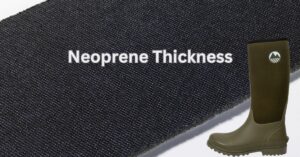Are Rain Boots Comfortable
Rain boots are designed to keep your feet dry and protected from the wet weather, but the level of comfort can vary depending on the design and material of the boots. Some rain boots are made with comfortable linings and insoles, while others may have a more rigid and stiff construction.
How comfortable rain boots feel comes down to personal preferences. Some people like a snug-fitting boot while other people prefer boots that have plenty of space, allowing feet to breathe.
Are rubber rain boots more comfortable than PVC rain boots
Rubber rain boots and PVC rain boots each have their own advantages and disadvantages. It can be difficult to say that one type is definitively better than the other, as it depends on individual needs and preferences.
However, here are some reasons why most people consider rubber rain boots to be better than PVC rain boots:
- Flexibility: Rubber rain boots tend to be more flexible, which can make them more comfortable for walking and moving around in.
- Supportability: Rubber boots generally provide better support around the foot and ankle. This is especially true of better quality rubber boots which are made from thicker rubber. The support the rubber provides is most beneficial for walking.
- Insulation: Rubber rain boots are typically better at insulating your feet and keeping them warm, especially in cold weather. However, it should be noted that even the thickest rubber boots are only a few millimetres thick and won’t offer much protection from sub-zero temperatures.
- Durability: Rubber is a more durable material and is less likely to crack or tear over time compared to PVC. Rain boots that split or get holes that let in water are defiantly not comfortable to wear
Rubber does have a few downsides when it comes to comfort:
- Breathability: Rubber is 100% waterproof both inside and outside, meaning that any moisture (sweat) that accumulates inside the boots cannot escape. The same is true for PVC rain boots as well. Some manufacturers have devised clever designs that effectively pump air around the rain boot as you walk, taking away excess moisture.
- Weight: Rubber isn’t an especially lightweight material and when making tall rain boots, a considerable amount of rubber is required. This can make rain boots slightly on the weighty side, which isn’t ideal for walking long distances or wearing all day. The thickness of PVC used to make rain boots is generally quite thin, which helps keep the weight down. So, this is possibly the one comfort advantage that PVC rain boots have over rubber rain boots.
BEST SELLING RAIN BOOTS
Last update on 2025-03-31 / Affiliate links / Images from Amazon Product Advertising API
Last update on 2025-03-31 / Affiliate links / Images from Amazon Product Advertising API
Last update on 2025-03-31 / Affiliate links / Images from Amazon Product Advertising API
Which rain boot linings are most comfortable
Rain boot linings refer to the material inside the rain boots that make them easier to put the boots on \ and take off, provide insulation and comfort. Several types of linings can be used in rain boots, including:
- Synthetic linings: Synthetic linings, such as polyester, are lightweight and provide next to no insulation from the cold. The primary purpose of thin synthetic lining is to help reduce friction, making it easier to put boots on and take them off. Sometimes they also provide moisture-wicking properties to keep your feet dry.
- Neoprene lining (Best for comfort): Neoprene is a synthetic rubber material that is often used in wetsuits. It has two big benefits when it comes to keeping feet comfortable in rain boots.
1) Neoprene has excellent insulating properties that will keep feet warm in the coldest of conditions
2) Neoprene is a sponge like material that provides cushioning and shock absorption making it ideal for keeping feet comfortable in rain boots. - Fabric linings: Fabric linings are often made of materials such as cotton, fleece or faux-fur and are designed to provide insulation and comfort. One of the downsides of fabric linings is that the more the boots if worn the more compressed the lining material becomes and is less effective at keeping feet warm and that snug feeling fades.
- Other Linings: Rain boots come with a variety of other linings, including wool, leather and a number of bespoke linings that have been uniquely created by manufacturers.
The type of lining you choose will depend on your individual needs and preferences, such as the type of weather you will be wearing the rain boots in and how long you plan to wear them for. It is important to choose a lining that will keep your feet comfortable and dry in the conditions you will be facing.
INSULATED RAIN BOOTS
Last update on 2025-03-31 / Affiliate links / Images from Amazon Product Advertising API
How to make rain boots more comfortable
Rain boots can be made more comfortable by incorporating various features, such as:
- Good fit: Choosing a size that fits well, allowing room for socks and enough space to move your toes, can help to make rain boots more comfortable. More information on how rain boots should fit
- Cushioned insole: A cushioned insole can provide extra padding and comfort for your feet, especially when wearing the boots for an extended period of time. Most rain boots do not provide very good arch support, so if you have high arches inserting special orthopaedic insoles can help improve comfort levels.
- Wearing socks: Wearing socks with rain boots have several benefits when it comes to comfort.
1) Socks provide a barrier between the boots and feet, this helps prevent rubbing that can cause sores and blisters
2) Socks help absorb moisture that builds up in the boots, keeping them dry and smell free
3) A decent pair of thick socks can provide a level of cushioning making the boots more comfortable.
4) Feet can feel the cold in boots that don’t have an insulating lining. Wearing socks will provide a reasonable of insulation from the cold, helping to keep feet warm - Break-in period: Some rain boots may require a break-in period to become more comfortable. Wearing the boots for shorter periods of time and gradually increasing the duration can help the material to soften and mould to your feet.
- Calf Adjustments: Some rain boots have adjustments on the shaft of the boot that enable the width to be changed. The most common type of adjustment is a strap and buckle.
In conclusion, rain boots can be very comfortable. Many factors affect how comfortable rain boots. Not everyone will find the same features provide additional comfort. The best way to determine if a pair of rain boots are comfortable is to try them out before purchasing.













